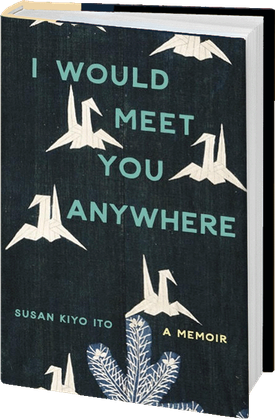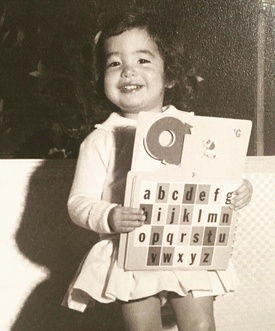I “met” Susan Ito online close to a decade ago on a social media site, where we bonded over being Japanese American writers and bloggers. The online friendship deepened over time. I discovered that she even met my uncle Hiroshi Kashiwagi at a Tule Lake pilgrimage. And we finally met in person a couple of years ago over cookies and crafts, with a mutual friend.
I’m so glad that Susan is telling her story with the 2023 publication of her memoir I Would Meet You Anywhere. The book is a powerful, poignant, and welcome addition to Japanese American literature: a story in part about being biracial, adoptee, and growing up on the East Coast. Nikkei readers might find the chapters on origami, taiko, and community pilgrimages interesting, but the whole book is a courageous and heartfelt exploration of identity, family, and belonging.
Here is how the publisher describes Susan’s book:
Growing up with adoptive Nisei parents, Susan Kiyo Ito knew only that her birth mother was Japanese American and her father white. But finding and meeting her birth mother in her early twenties was only the beginning of her search for answers, history, and identity. Though the two share a physical likeness, an affinity for ice cream, and a relationship that sometimes even feels familial, there is an ever-present tension between them, as a decades-long tug-of-war pits her birth mother’s desire for anonymity against Ito's need to know her origins, to see and be seen.
Along the way, Ito grapples with her own reproductive choices, the legacy of the Japanese American incarceration experience during World War II, and the true meaning of family. An account of love, what it’s like to feel neither here nor there, and one writer’s quest for the missing pieces that might make her feel whole, I Would Meet You Anywhere is the stirring culmination of Ito’s decision to embrace her right to know and tell her own story.
* * * * *
Tamiko Nimura (TN): Yours is a rarely told story about growing up adopted and Japanese American on the East Coast; your adoptive parents did not go to camp, though your adoptive father was in the 442nd. Can you talk a bit more about finding your own ways into a Japanese American identity?
Susan Ito (SI): It meant a lot to me that we belonged to a Japanese American church in New York City. We went every week and spent 5-8 hours there. In addition to bilingual services, we took turns preparing lunch for the entire congregation. It was a huge community building exercise that I remember from being very small. I loved pouring tea out of those metal kettles every week, loved being in the Youth Fellowship as a teenager. We had annual church picnics and bazaars.
Additionally, we spent many weekends and holidays with extended family—aunts, uncles, cousins—and that was a big part of my upbringing. Even though my parents and I lived in a small town with no other Japanese Americans (and few people of color), I felt very connected to the JA community through church and family.
I had a transition to manage when I moved to the West Coast as a young adult. When I was away from my parents, I lost that “bridge” to the JA community and at first I felt like I didn’t belong. I felt like an outsider. Eventually, this changed but I didn’t feel immediately seen by other JA people, as a biracial Japanese American. It took me several years to claim that identity on my own, without leaning on my parents to bring me in.
TN: I read somewhere that the book took you 30 years to write—and it’s clear that every word is hard-earned. Can you talk in more depth about the process of writing the book, and why it was a long process?
SI: I started the book as my MFA thesis 30 years ago. At the time it was a fictional book titled Filling in the Blanks. I was just trying to find answers for myself, and resorted to fiction to make up things I didn’t understand or know about. I was really trying to recreate my own history through fiction writing.
Eventually, after two novel drafts, I realized that I had been seeking certain truths, and I didn’t want to write fiction anymore. I wanted to write the truth of my own story. Of course, there were many long periods of withdrawing from the book. There were times when I lost confidence in my writing, in my ability to tell the story, and my right to tell it. I would go away and kind of give up on it, but something always drew me back. I felt like I could not put decades of my life into a project and then give up.
TN: How do you hope your story will reach Japanese American readers (in all their multiplicities) specifically?
SI: I hope that JA readers will feel seen and also see things they maybe weren’t aware of. Because my adoptive family was not incarcerated, I think that is something that West Coast Japanese Americans may be less aware of. When my adoptive mother moved to California, I brought her to a seniors gathering and they all wanted to know what camp she was in. When she said she was not in camp, some of them didn’t even believe her. She felt a little left out after this, but eventually was able to make friends regardless.
I hope it will shine some light on the 442nd experience, which was such an important part of my father’s life. I hope that they will understand some of the things that biracial or multiracial JAs experience. And of course, there might be resonance for those who did have the camp experience, like my birth mother, and the long legacy of that.
TN: Thus far, what has been the best, surprising, or most rewarding part of bringing this book to fruition?
SI:It has not been out very long, but so far, I’ve been very moved by people who have shared various aspects of my experience and said how much they resonated. I’ve heard from several biracial Asian Americans, people who have had complicated family relationships, adopted people, Japanese Americans and others. It has been incredibly rewarding for them to tell me they felt that my story resonated or mirrored them on some level.
And on the other hand, the opposite—people who have NOT shared aspects of my experience, who felt that they were illuminated, that they learned something new about something they hadn’t been aware of previously. When somebody said they learned something about the adoption experience, or the multiracial experience, that has been very meaningful for me.
TN: What advice would you give other Nikkei (and/or biracial) writers who want to tell their stories?
SI: Nikkei people are not a monolith. We all have so many unique and nuanced stories. I want them ALL to be told so that people within and outside the community can understand the rich, complex tapestry that is Nikkei experience. I would encourage Nikkei writers to tell and write their stories, whether they be just for their own selves, their families or a wider audience. All of our stories matter.
*Susan’s book is available at bookstores and online. She is appearing at a number of events, listed at her website.
© 2023 Tamiko Nimura








